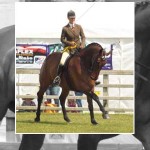Connolly’s Red Mills Discuss Feed Balancers
Written by Nia O’Malley, Equine Nutritionist
Connolly’s Red Mills
Feed balancers are a relatively new concept in feeding horses. A balancer is a low-intake, concentrated source of essential protein, vitamins, and minerals, which is designed for all classes of horses when additional calories are not required. A balancer will not contribute a significant amount of calories to the horse’s diet because of the low feeding rate, but it will provide the essential nutrients to “balance” a diet based on forage and straights. They are usually in pelleted form but are also available as a textured mix. Balancers can be used in three ways: fed alone as a low-calorie source of protein, vitamins, and minerals, combined with straights and beet pulp to balance out deficiencies or fed as a ‘top-dress’ for a concentrate to enhance nutrient density of the overall feed. When used in this way it is advisable to feed the balancer at less than the recommended feeding rate.
A balancer is a lot like a vitamin/mineral supplement for your horse but differs in the amount of protein and macrominerals that it adds to your horse’s diet. The balancer pellet supplies essential amino acids and adequate amounts of the macrominerals calcium, phosphorus and magnesium. Providing adequate amounts of these minerals is not possible when feeding a 50-100 g of a vitamin and mineral supplement. These supplements generally supply microminerals and vitamins but not protein or macro minerals.
Balancers are available with a range of protein levels. Deciding on which balancer to use depends on the quality and protein level in the forage and the requirements of the horse. The protein levels may appear to be quite high, 25% and 30% in some cases, but the quantities fed are relatively small in comparison to feeding concentrates. Feeding rates of 100g/100kg BW/d would be typical for most balancers. So for example: 500 g of a 30% stud balancer will provide 150 g of protein (0.5 x 300). Whereas 3 kg of a 10% cool feed will provide 300g of protein (3 x 100). The 3kg of a cool feed provides twice as much protein.
Balancers are formulated with high levels of vitamins and minerals in comparison to concentrate feeds. A typical feed might have 40-60 mg/kg copper while a balancer pellet would have 160-200 mg/kg, approximately four times the amount. The same holds true for all of the minerals and vitamins. Calcium and phosphorus concentration in a balancer pellet may be double that which is normally found in a typical concentrate. When feeding the minimum requirement of a balancer, no other type of vitamin or mineral supplement should be required as the horse should be able to get all of its required daily vitamins and minerals from the balancer. However this will depend on the forage that is available to the horse. It is strongly recommended to carry out a forage and soil analysis in order to highlight any nutrient excesses, deficiencies or imbalances in the horses diet.
In the case where a horse already on a concentrate diet may benefit from additional high-quality protein and minerals and vitamins, top dressing the existing feed with a balancer will enhance the nutrient density of the feed. This would be typical for a horse returning to work after a long rest period, a horse that needs to build extra muscle, a horse recovering from injury or illness, older horses, younger horses, etc. Recommended supplementation would be 50g/100kg BW/d on top of the horse’s regular daily feed depending on the individual’s requirements.
Horse feeds are formulated to be fed at a certain feeding rate. Some horses do not receive the recommended feeding rate because it provides too many calories for the metabolism of that horse, often leading to obesity. When fed below the recommended feeding rate, the horse does not receive the appropriate levels of protein, vitamins, and minerals. For example if 2 kg of feed is supplying 100 mg of copper, then 0.5 kg of feed would supply only 25 mg of copper, which is well below the horse’s copper requirement.
If supplementing some of the concentrate diet with a balancer the recommended guideline for supplementation would be for every kilogram under the recommended feeding rate, top-dress with 250 g of balancer pellet. For example, if a feed has a recommended feeding rate of 5 kg per day, but the horse is only getting 4 kg per day and maintaining weight well, then adding 250 g of a balancer pellet to the diet will raise the vitamin, mineral, and protein concentration to meet the horse’s requirements.
Many people like to make up their own feed and incorporate straights such as oats, barley, maize, beet pulp, alfalfa chaff, rice bran and oil. These are all great ingredients, but unfortunately they are not nutritionally balanced by themselves. Balancers can be used to supplement this type of a feeding programme. The main components of the feed provide the calories and the balancer is added to ‘fill in the nutritional gaps’ of these ingredients, supplying essential amino acids, vitamins, and minerals. The beauty of using a balancer pellet is the flexibility it provides in customizing the nutritional management of individual horses. If fed properly, a balancer pellet can ensure that all of the horses on a farm receive the nutrients needed to grow, perform, or reproduce.
Several of the modern horse breeds were developed to maintain weight on limited calories, even when they were asked to perform hard work. Many horses are easy keepers, meaning that they can survive on fewer calories. Because of the concentrated nature and low feeding rate, a balancer pellet can meet all the protein, vitamin, and mineral needs of the horse without adding excessive calories or starch to the diet. The carrier for a balancer pellet may have a few calories but is not calorie-dense like most other feeds formulated for a higher feeding rate and designed to add calories to the diet.
Barren mares and those out on grass that tend towards the heavier side benefit from being fed a balancer, which when fed at the recommended daily intake for a broodmare, approx 200g/100kg BW/d, provides a base nutrient package during all phases of the breeding cycle. However the mare’s feeding program should be adjusted to accommodate the differences in requirements during gestation and lactation. During this period feeding recommendations of a balancer generally increase to 300g/100kg BW/day. The additional energy required for late gestation and lactation if not provided by the forage may need to be provided by straights or a concentrate.
A balancer pellet is a useful yet little understood type of horse feed. Though the pellet might look no different than other pelleted feeds, it can be a dynamic addition to any feeding programme. Balancers are a very versatile feedstuff. Horse owners have the options to feed it on its own to horses that are maintained on all-forage diets, or add it to feeds when extra nutritional fortification is required and can also feed it with unfortified grains to provide the correct balance of nutrients. The true advantage of using a balancer pellet is that the horse owner can meet the individual horse’s requirement for protein, vitamins, and minerals and control the amount of energy supplied to each horse.
When a horse is receiving a fully balanced diet all the nutrients needed for general health and well being will be provided. A balanced diet will be reflected in your horse by a well developed top line, improved body and coat condition, strong healthy hooves, improved post exercise recovery times and staying power, improved fertility, milk production and easier foalings, a healthier gut and better feed utilisation and overall a much happier animal.
Feed balancers produced by Connolly’s RED MILLS include the following: GroCare Balancer – a stud balancer for young growing stock, broodmares and stallions; LamiCare Balancer – a balancer for the ‘good-doer’, the laminitis prone horse or for those with poor hoof condition; Formula Gold Balancer – a low protein textured mix balancer for the competition/leisure horse; Oat Balancer Mix and Oat Balancer Pellet – both formulated to be combined with straights.
Category: Business Features, Features, Health












